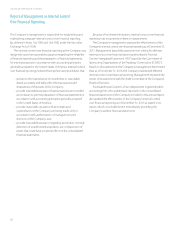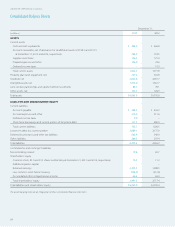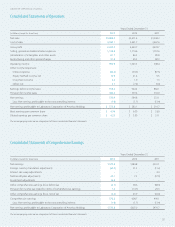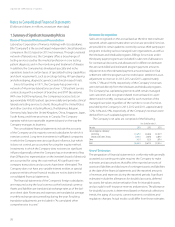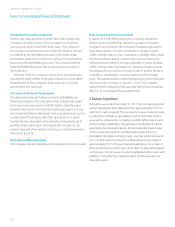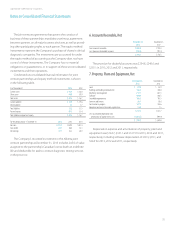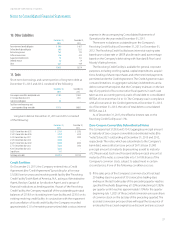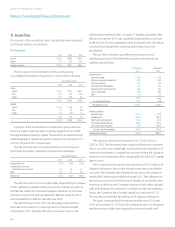LabCorp 2013 Annual Report Download - page 35
Download and view the complete annual report
Please find page 35 of the 2013 LabCorp annual report below. You can navigate through the pages in the report by either clicking on the pages listed below, or by using the keyword search tool below to find specific information within the annual report.
31
LABORATORY CORPORATION OF AMERICA
Notes to Consolidated Financial Statements
Step One of the goodwill impairment test includes the estimation
of the fair value of each reporting unit as compared to the book value
of the reporting unit. The Company uses a market value approach
for determining fair value and utilizes a number of factors such as
publicly available information regarding the market capitalization of
the Company as well as operating results, business plans, and present
value techniques. If Step One indicates potential impairment, the
second step is performed to measure the amount of the impairment.
The Company has indefinite-lived assets consisting of acquired
Canadian licenses. When a quantitative analysis is considered
necessary for indefinite-lived intangible assets, the Company utilizes
an income approach to determine the fair value. It then compares
the carrying value of the indefinite-lived asset to its fair value.
Impairment losses are recorded to the extent that the carrying
value of the indefinite-lived intangible asset exceeds its fair value.
There are inherent uncertainties related to the factors described
above and judgment related to the Company’s impairment assess-
ments of goodwill and indefinite-lived intangibles. The assumptions
underlying the impairment analyses may change in such a manner
that impairment in value may occur in the future. Any such impair-
ment will be recognized in the period in which it becomes known.
The Company completed an annual impairment analysis
of its indefinite lived assets, including goodwill, and has found no
instances of impairment as of December 31, 2013 or 2012.
Long-lived assets, other than goodwill and indefinite-lived
assets, are reviewed for impairment whenever events or changes in
circumstances indicate that the carrying amounts may not be
recoverable. Recoverability of assets to be held and used is deter-
mined by the Company at the level for which there are identifiable
cash flows by comparison of the carrying amount of the assets to
future undiscounted net cash flows before interest expense and
income taxes expected to be generated by the assets. Impairment,
if any, is measured by the amount by which the carrying amount
of the assets exceeds the fair value of the assets (based on market
prices in an active market or on discounted cash flows). Assets to
be disposed of are reported at the lower of the carrying amount or
fair value. The Company found no instances of impairment as of
December 31, 2013 or 2012.
Intangible Assets
Intangible assets are amortized on a straight-line basis over the
expected periods to be benefited, as set forth in the table below,
such as legal life for patents and technology and contractual lives
for non-compete agreements.
Years
Customer relationships 10-30
Patents, licenses and technology 3-15
Non-compete agreements 5-10
Trade names 5-10
Debt Issuance Costs
The costs related to the issuance of debt are capitalized and
amortized to interest expense over the terms of the related debt.
Professional Liability
The Company is self-insured (up to certain limits) for professional
liability claims arising in the normal course of business, generally
related to the testing and reporting of laboratory test results. The
Company estimates a liability that represents the ultimate exposure
for aggregate losses below those limits. The liability is discounted
and is based on actuarial assumptions and factors for known and
incurred but not reported claims, including the frequency and
payment trends of historical claims.
Income Taxes
The Company accounts for income taxes utilizing the asset and
liability method. Under this method deferred tax assets and liabilities
are recognized for the future tax consequences attributable to
differences between the financial statement carrying amounts
of existing assets and liabilities and their respective tax bases and
for tax loss carryforwards. Deferred tax assets and liabilities are
measured using enacted tax rates expected to apply to taxable
income in the years in which those temporary differences are
expected to be recovered or settled. The effect on deferred tax
assets and liabilities of a change in tax rates is recognized in income
in the period that includes the enactment date. The Company does
not recognize a tax benefit unless the Company concludes that it
is more likely than not that the benefit will be sustained on audit
by the taxing authority based solely on the technical merits of the
associated tax position. If the recognition threshold is met, the
Company recognizes a tax benefit measured at the largest amount
of the tax benefit that the Company believes is greater than 50%
likely to be realized. The Company records interest and penalties in
income tax expense.



